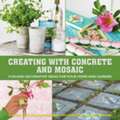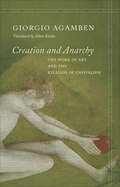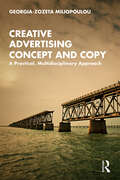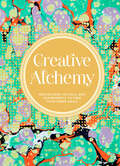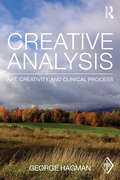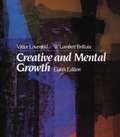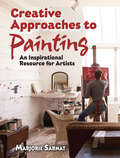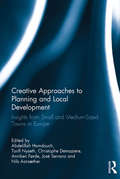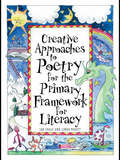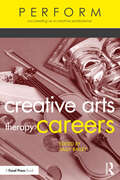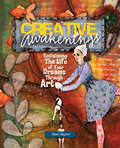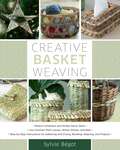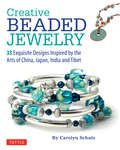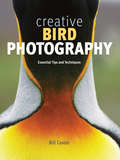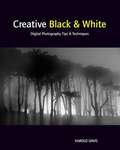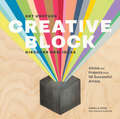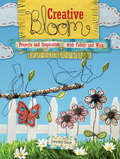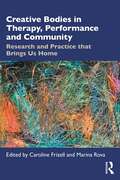- Table View
- List View
Creating with Concrete and Mosaic: Fun and Decorative Ideas for Your Home and Garden
by Sania Hedengren Susanna ZackeCasting in concrete is an exciting project that is both enjoyable and practical. You can create all sorts of decorations and furniture for your home that are sure to be the envy of all your neighbors. But the fun doesn’t have to stop there! Concrete lends itself to many unique and exquisite projects, and decorating these pieces with beautiful mosaic patterns makes them all the more impressive. Here, interior decorating journalists and stylists Sania and Susanna show you how to do that. Decorating with mosaic and pouring concrete are both addictive; once you start, you won’t want to stop. With step-by-step photos and instructions, Sania and Susanna show you how to create more than twenty different decorations and ornate trinkets. Whether you’re someone looking to create a new decoration for your home or a fledgling concrete caster, this book has a little something for everyone. The sky is the limit! Let your imagination run wild, and be inspired!
Creating with Paper: Basic Forms and Variations
by Pauline JohnsonThis comprehensive and superbly illustrated guidebook offers complete instructions for making an almost limitless variety of imaginative and beautiful paper objects -- masks, hats, baskets, greeting cards, party decorations, costumes, trees, Christmas decorations, stars, birds, giftwrap, even mobile sculptures.Art educator Pauline Johnson provides step-by-step instructions and expert advice on every technique involved: cutting, curling, bending, folding, scoring, fastening, and more. Over 470 photographs and 560 diagrams and illustrations accompany the easy-to-follow directions. Best of all, no complicated equipment is needed. Paper, a pair of scissors, an X-ACTO knife, staples, and adhesives are the only tools and supplies required to begin making paper magic!
Creation and Anarchy: The Work of Art and the Religion of Capitalism (Meridian: Crossing Aesthetics)
by Giorgio Agamben , L.P.C.Creation and the giving of orders are closely entwined in Western culture, where God commands the world into existence and later issues the injunctions known as the Ten Commandments. The arche, or origin, is always also a command, and a beginning is always the first principle that governs and decrees. This is as true for theology, where God not only creates the world but governs and continues to govern through continuous creation, as it is for the philosophical and political tradition according to which beginning and creation, command and will, together form a strategic apparatus without which our society would fall apart. The five essays collected here aim to deactivate this apparatus through a patient archaeological inquiry into the concepts of work, creation, and command. Giorgio Agamben explores every nuance of the arche in search of an an-archic exit strategy. By the book's final chapter, anarchy appears as the secret center of power, brought to light so as to make possible a philosophical thought that might overthrow both the principle and its command.
Creative Acrylic Landscapes
by Wendy JelbertWendy Jelbert shares her expertise in working with acrylics and in creating beautiful, convincing landscapes. There is information on what materials to buy, how to use sketches and photographs, how to look at landscape shapes and how to use tone and composition to good effect. Wendy demonstrates a variety of acrylic techniques and explains elements of the landscape such as foregrounds, distances and skies. There are six beautiful step-by-step demonstrations with clear photographs and instructions for readers to follow.
Creative Advertising Concept and Copy: A Practical, Multidisciplinary Approach
by Georgia-Zozeta MiliopoulouConsidering perspectives on creative advertising through a unique media and communications lens, this book encompasses both the theory and practical tools needed to approach and understand creativity in advertising with an original eye.Drawing from diverse subject areas including Social Anthropology, Narrative Theory, Consumer Psychology, Semiotics and Cultural Studies, Creative Advertising Concept and Copy provides a solid grounding in advertising education away from the traditional business and marketing literature. Notwithstanding the need for independent inspiration and originality, the author guides readers through the entire process of campaign planning, moving from strategy to creative idea to finished piece whilst employing concepts and principles relevant to ‘design thinking’. Taking into account ethics and regulations, the use of text and images, and storytelling across radio, TV and video platforms, readers will come to a holistic understanding of what advertising can (and cannot) do, and how to achieve the best results.Written for students involved in creative advertising as an area of academic research and professional practice, this book will also be of interest to early-career advertising professionals seeking a fresh perspective on their work.
Creative Agency (Palgrave Studies in Creativity and Culture)
by Dan HarrisThis book offers a socio-cultural examination of contemporary creativity studies. Drawing heavily on posthumanist, new materialist and affective theoretics, the author argues in favour of an expansive and sustainable approach to creativity which contributes to an emergent ‘creativity studies’ inter-discipline. It seeks to establish a broader consideration of creativity in socio-culture, that extends beyond, or indeed refutes, the narrowing aperture of entrepreneurship and innovation as synonyms for creativity in economic, cultural and educational contexts and discourses. Drawing on multiple case studies of creative relational and creative ecological empirical research, this book integrates a concern for personal, planetary and geo-political collaboration, as an antidote for ‘innovation for innovation’s sake’.
Creative Alchemy: Meditations, Rituals, And Experiments To Free Your Inner Magic
by Marlo JohnsonCreativity guru Marlo Johnson guides readers through 88 transformative meditations, rituals, and experiments designed to foster personal growth through the power of conscious creation. Featuring dreamy marbled-paper interiors and a refreshing combination of down-to-earth practical instruction and insightful spiritual guidance, this gem of a book is perfect for anyone looking to break out of old habits and unleash their true creative potential.
Creative Analysis: Art, creativity and clinical process (Psychoanalytic Inquiry Book Series)
by George HagmanCreative Analysis: Art, Creativity and Clinical Process explores the dynamics of creativity in psychoanalytic treatment. It argues that the creative process of the analytic interaction is characterized by specific forms of feeling, thinking and most importantly, relating that result in the emergence of something new – therapeutic change. The artistic aspects of psychoanalysis and various features of creativity in analytic treatment are explored. Clinical examples are discussed at length. George Hagman presents a new model of the psychology of creativity and art that helps us to better understand the clinical process. The book explores and develops several important implications of Hagman’s main thesis: the psychodynamics of art, the creativity of the brain, aesthetic aspects of the treatment relationship, the creativity of the analyst and analysand. Change in analysis is driven not just by the analyst’s interventions but the patient’s own motivation and capacity for self-transformation. This change is depicted here as a depth psychological process which explores the sources of the patient’s resistance to self-actualization and identifies hidden potential, unrealized capacities and strengths. Creative Analysis: Art, Creativity and Clinical Process reformulates psychoanalytic therapy as a form of art that can help patients realize their potential which may have been blocked, inhibited, denied or derailed. The book will be of interest to psychoanalysts, psychotherapists, graduates and students, including the educated public interested in art.
Creative And Mental Growth
by Viktor Lowenfeld W. BrittainChildren are the essence of this book, but more than that, they are the essence of society. Creative and intellectual growth are the basis of any educational system, and it is the hope that this book can contribute to an understanding of the importance of this area so as to make the education of children a joyful and meaningful experience.
Creative Approaches to Painting: An Inspirational Resource for Artists (Dover Art Instruction)
by Marjorie SarnatDiscover how to find and keep your inspiration and how to advance your visual style with this collection of more than 200 imaginative ideas for painting. Students, teachers, and professionals alike can benefit from this guide, which suggests clever and resourceful concepts for paintings and shows how to identify sources of inspiration. In addition to tips on ways to organize ideas, it proposes unusual methods with innovative materials and offers advice, answers, and techniques for artists of every style. <P><P> Award-winning artist and author Marjorie Sarnat encourages artists to make this book their own by highlighting entries, tagging pages, and jotting down their own ideas in the margins and on the note pages provided. This immensely useful volume will complement any studio or classroom reference library and provide a reading companion for visual artists. The practical and imaginative suggestions offer artists an opportunity to do more — and to do it better.
Creative Approaches to Planning and Local Development: Insights from Small and Medium-Sized Towns in Europe
by Christophe Demaziere Abdelillah Hamdouch Torill Nyseth Anniken Førde José Serrano Nils AarsætherThis book project highlights creative approaches to planning and local development. The dynamic complexity, diversity and fluidity which characterize contemporary society represent challenges for planning and development endeavours. While research and policy work has extensively focused on large cities and on metropolitan regions, there has been relatively little work on ‘smaller places’. This book shows that if these new challenges affect all places and regions, small and medium-sized towns (SMSTs) are suffering many specific problems that call imperatively for the design and implementation of very imaginative, creative approaches to planning and local development. What could enhance creativity in local development and planning? Is it possible to talk about creative capacity building at the level of a town that might release imaginative and innovative activities? Under what local and non-local conditions is creativity being initiated and flourishing? What are the major obstacles and in what way can these be contained in order to safeguard pockets of creative action? Interdisciplinary and with case studies from France, Norway and other European countries, this volume presents a wide range of approaches and territorial contexts of small cities and towns in which spatial dynamics and the consequences of the city-region for urban planning theory and practice in Europe are highlighted, with a special focus on the challenges for - and understanding of - planning and development of SMSTs. It provides a significant body of critical, comparative and contextual perspectives on the quest for urban sustainability and resilience in SMSTs, therefore emphasizing collaborative and potentially innovative approaches that can be detected, but also the shortcomings, pitfalls and 'traps' that can lie behind the approaches aimed at concerting ecological, economic, and socio-cultural concerns, and the discourses promoting them.
Creative Approaches to Poetry for the Primary Framework for Literacy
by Jan Foale Linda PagettCreative Approaches to Poetry for the Primary Framework for Literacy supports teachers in planning, teaching and, most importantly, enjoying poetry with their pupils. With an emphasis on creative, cross curricular approaches the authors explore tried and tested methods of teaching poetry in an engaging and comprehensive manner. A carefully considered range of poems has been included in order to expand children’s repertoires in a variety of poetic forms. Chapters cover: how to develop a range of creative approaches to teaching poetry, involving visualisation, drama, choral speaking, performance, discussion and writing how to engage children from a variety of backgrounds and abilities in experiencing poetry in its many forms integrating the teaching of poetry with all other areas of the curriculum including ICT and citizenship effectively linking all work to the KS1 poetry units of the renewed Primary National Framework for Literacy an innovative model that takes children on a journey beginning before they meet the poem through to becoming poets themselves. This accessible and user-friendly book includes informative case studies, photographs and children’s work to demonstrate alternative routes to working with poetry. It will prove an invaluable resource for all primary teachers seeking to employ progressive and effective strategies in the teaching of poetry.
Creative Arts Therapy Careers: Succeeding as a Creative Professional (ISSN)
by Sally BaileyCreative Arts Therapy Careers is a collection of essays written by and interviews with registered drama therapists, dance/movement therapists, music therapists, art therapists, poetry therapists, and expressive arts therapists.The book sheds light on the fascinating yet little-known field of the creative arts therapies – psychotherapy approaches which allow clients to use creativity and artistic expression to explore their lives, solve their problems, make meaning, and heal from their traumas. Featuring stories of educators in each of the six fields and at different stages of their career, it outlines the steps one needs to take in order to find training in one of the creative arts therapies and explores the healing aspects of the arts, where creative arts therapists work, who they work with, and how they use the arts in therapy. Contributors to this book provide a wealth of practical information, including ways to find opportunities to work with at-risk populations in order to gain experience with the arts as healing tools; choosing the right graduate school for further study; the difference between registration, certification, and licensure; and the differences between a career in a medical, mental health, educational, correctional, or service institution.This book illuminates creative arts therapy career possibilities for undergraduate and graduate students studying acting, directing, playwriting, creative writing, visual arts, theatre design, dance, and music. It is also an excellent resource for instructors offering a course to prepare arts students of all kinds for the professional world.
Creative Arts Therapy Careers: Succeeding as a Creative Professional (PERFORM)
by Sally BaileyCreative Arts Therapy Careers is a collection of essays written by and interviews with registered drama therapists, dance/movement therapists, music therapists, art therapists, poetry therapists, and expressive arts therapists. The book sheds light on the fascinating yet little-known field of the creative arts therapies – psychotherapy approaches which allow clients to use creativity and artistic expression to explore their lives, solve their problems, make meaning, and heal from their traumas. Featuring stories of educators in each of the six fields and at different stages of their career, it outlines the steps one needs to take in order to find training in one of the creative arts therapies and explores the healing aspects of the arts, where creative arts therapists work, who they work with, and how they use the arts in therapy. Contributors to this book provide a wealth of practical information, including ways to find opportunities to work with at-risk populations in order to gain experience with the arts as healing tools; choosing the right graduate school for further study; the difference between registration, certification, and licensure; and the differences between a career in a medical, mental health, educational, correctional, or service institution. This book illuminates creative arts therapy career possibilities for undergraduate and graduate students studying acting, directing, playwriting, creative writing, visual arts, theatre design, dance, and music. It is also an excellent resource for instructors offering a course to prepare arts students of all kinds for the professional world.
Creative Awakenings: Envisioning the Life of Your Dreams Through Art
by Sheri GaynorUtilize your creativity to manifest your personal intention. Work in the spirit of the laws of attraction to visualize the life of your dreams. Follow the journey of twelve artists, each who will set a personal dream or intention. Witness the process that each artist takes, as they create a mixed-media piece that sows the seeds of their intention. Step-by-step techniques for a variety of mixed-media processes accompany each piece of finished art. Read about how their lives changed as a result and learn how to set intentions of your own using the bonus tear-out "dream-prompt" cards.
Creative Ballet Teaching: Technique and Artistry for the 21st Century Ballet Dancer
by Cadence WhittierHow do teachers create a classroom environment that promotes collaborative and inquiry-based approaches to learning ballet? How do teachers impart the stylistic qualities of ballet while also supporting each dancer’s artistic instincts and development of a personal style? How does ballet technique education develop the versatility and creativity needed in the contemporary dance environment? Creative Ballet Teaching draws on the fields of Laban/Bartenieff Movement Analysis (L/BMA), dance pedagogy, and somatic education to explore these questions. Sample lesson plans, class exercises, movement explorations, and journal writing activities specifically designed for teachers bring these ideas into the studio and classroom. A complementary online manual, Creative Ballet Learning, provides students with tools for technical and artistic development, self-assessment, and reflection. Offering a practical, exciting approach, Creative Ballet Teaching is a must-read for those teaching and learning ballet.
Creative Basket Weaving: Step-by-Step Instructions for Gathering and Drying, Braiding, Weaving, and Projects
by Sylvie BegotSo many interesting basketry designs can be made from plant leaves and bark you find in nature or purchase from suppliers. Projects are divided by the type of plant used: iris leaves, cattail leaves, willow stems, and bark. Learn where and how to harvest and prepare what you need, and the basic materials and weaving techniques. Then weave the 25 projects, ranging from traditional baskets to wall-hangings to a shoulder bag, pencil cup, Christmas decorations, and much more. The projects are both functional and modern in style and add a natural accent to your home.
Creative Beaded Jewelry
by Carolyn SchulzThis inspiring book presents 33 simple beaded jewelry designs that are easy and inexpensive to make using materials found in every craft store--beads, chains, beading wires and cords. Author Carolyn Schulz shows you how to make your own gorgeous jewelry by mastering a few simple techniques. The results are elegant and look expensive--but are not! Create a colorful bracelet embellished with Chinese floral and butterfly motifs, or a gold-and-pearl lariat inspired by the fringe of an Indian carpet, or a stunning Shamballa bracelet. Detailed instructions and diagrams are included for each design, which are easy for beaders at all levels to follow. Stunning color photos help you create your own designs. Put the world on a string with Creative Beaded Jewelry! The exquisite jewelry designs in this book include:An Exquisite Pearl Bracelet A Jade & Onyx Watch Chinese Flower and Butterfly Bracelet Aqua Lampwork Bracelet with Silver Tubes Turquoise & Coral Floating Necklace Patina Donut Necklace Amethyst Shamballa Bracelet Abalone Shell Ensemble (bracelet, necklace and matching earrings) Elephant & Jade Necklace and Earrings
Creative Beaded Jewelry
by Carolyn SchulzThis inspiring book presents 33 simple beaded jewelry designs that are easy and inexpensive to make using materials found in every craft store--beads, chains, beading wires and cords. Author Carolyn Schulz shows you how to make your own gorgeous jewelry by mastering a few simple techniques. The results are elegant and look expensive--but are not! Create a colorful bracelet embellished with Chinese floral and butterfly motifs, or a gold-and-pearl lariat inspired by the fringe of an Indian carpet, or a stunning Shamballa bracelet. Detailed instructions and diagrams are included for each design, which are easy for beaders at all levels to follow. Stunning color photos help you create your own designs. Put the world on a string with Creative Beaded Jewelry! The exquisite jewelry designs in this book include:An Exquisite Pearl Bracelet A Jade & Onyx Watch Chinese Flower and Butterfly Bracelet Aqua Lampwork Bracelet with Silver Tubes Turquoise & Coral Floating Necklace Patina Donut Necklace Amethyst Shamballa Bracelet Abalone Shell Ensemble (bracelet, necklace and matching earrings) Elephant & Jade Necklace and Earrings
Creative Beaded Jewelry
by Carolyn SchulzCraft colorful and unique jewelry with this Asian inspired craft book.Bracelets embellished with Chinese floral and butterfly motifs, a gold-and-pearl lariat inspired by the fridges of a Persian carpet, and the pupular Shamballa bracelet- these are just a few of the many artful pieces you'll learn to make in this wonderful new book by DIY jewelry artist Carolyn Schulz. Suitable for novices and experienced jewelry-making experts alike, some of the projects take just a few minutes to complete, and all of them are fun and inexpensive to do. They result in jewelry that looks great and can be worn anywhere!Most of the 33 jewelry projects in this jewelry making book use materials you can find in any craft store. The simple techniques of working with chain, beading wire, memory wire, stretch/elastic cord, cotton cord and nylon cord are all clearly explained. When combined with creatively chosen beads, they result in beautiful beaded bracelets, necklaces, earrings and rings you'll be proud to wear and give to friends.Jewelry techniques include: Wire Strung Jewelry Loop & Chain Jewelry Memory Wire Jewelry Knotted Jewelry Elastic Cord Bracelets
Creative Bird Photography
by Bill CosterThis beautifully illustrated, inspirational guide to bird photography is packed with practical advice for how to photograph birds presented in an informative but accessible writing style. Creative Bird Photography offers a fresh approach to its subject, looking closely at how to photograph specific aspects of birds' lives, such as eating and drinking, courtship, and flight. The author gives examples, demonstrating particular points and approaches for taking great shots of all of these daily bird activities as well as taking "mood" photographs at dawn and dusk. Each shot is accompanied by detailed technical data, information about locations, and advice about other challenges that will need to be surmounted in order to achieve the perfect shot. Coster also shares fascinating anecdotes about his encounters with the birds featured. There are also up-to-date sections on bird photography basics, including equipment and storage of digital images.
Creative Black and White
by Harold DavisLearn how breaking photographic rules can result in stunning black-and-white photosBlack-and-white photography poses unique challenges; without color to guide the eye, contrast, lighting, and composition take on even more importance. Renowned photographer Harold Davis explains these elements and demonstrates the basic rules of black and white photography as well as when and how to break them. He breaks through the complexity of this photographic medium, explores opportunities for black-and-white imagery, and shows how to capitalize on every one.Richly illustrated with the author's own images, this beautiful guide presents the skills needed for great black-and-white photos while encouraging your confidence and creativity.Goes beyond basics to teach photographers how to conquer the challenges posed by black-and-white photographyAppeals to professionals and serious amateurs who are interested in exploring creative black-and-white imageryPresents photography fundamentals and shows how black and white requires some of the rules to be bentEncourages creative thinking and confidenceLavishly illustrated with Harold Davis's outstanding monochromatic photosWhether you're a professional just venturing into black and white or a serious amateur, Creative Black & White will both educate and inspire you.
Creative Block: Get Unstuck, Discover New Ideas
by Anne M. ZemanCreative block presents the most crippling—and unfortunately universal—challenge for artists. No longer! This chunky blockbuster of a book is chock-full of solutions for overcoming all manner of artistic impediment. The blogger behind The Jealous Curator interviews 50 successful international artists working in different mediums and mines their insights on how to conquer self-doubt, stay motivated, and get new ideas to flow. Each artist offers a tried-and-true exercise—from road trips to 30-day challenges to cataloging the medicine cabinet— that will kick-start the creative process. Abundantly visual with more than 300 images showcasing these artists' resulting work, Creative Block is a vital ally to students, artists, and creative professionals.
Creative Bloom: Projects and Inspiration with Fabric and Wire
by Jennifer SwiftCultivate Your Inner Artist! Prepare your own garden of self-expression with the creative fabric and wire projects inside Creative Bloom. The seeds of inspiration will be planted as you learn how to make a butterfly-adorned lamp, a sweet bird sculpture, an inspired canvas bag and a sparkling cloud cuff. Each project features innovative techniques that you can use again in your personal artwork. Creative Bloom features: 21 pretty projects for your art studio, home and wardrobe Vignettes and advice on gathering the right tools, forcing creative growth, finding inspiration in the seasons and staying motivated Step-by-step techniques that show you how sculpt wire, stitch fabric to wire, make fabric pages and more! Grab some wire and rummage through your fabric stash. It's time to unearth your creative potential!
Creative Bodies in Therapy, Performance and Community: Research and Practice that Brings us Home
by Marina Rova Caroline FrizellCreative Bodies in Therapy, Performance and Community champions several diverse and innovative approaches in the professional engagement with the creative body as a catalyst for change in therapy, education, somatics and performance. With contributors from the wide-ranging fields of performance and visual arts, psychotherapy, dance and somatics, this book articulates practice-based experiences in a creative language. The readers are invited to move from the process of reading, into the experience of being in and making sense of the world through a moving body. The book meanders purposefully through practice-led embodied approaches in research that generate new knowledge, methodological frameworks that have emerged in response to the needs of different contexts, as well as offerring a window on first-hand experience as practice. The book will appeal to a wide range of practitioners and trainees in Dance Movement Psychotherapy, arts therapies, counselling and psychotherapy, somatics, community practice and performance.
